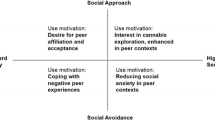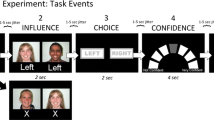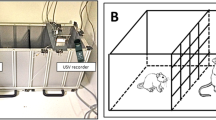Abstract
Purpose of Review
Although peer influence is an important factor in the initiation and maintenance of cannabis use, few studies have investigated the neural correlates of peer influence among cannabis users. The current review summarizes research on the neuroscience of social influence in cannabis users, with the goal of highlighting gaps in the literature and the need for future research.
Recent Findings
Brain regions underlying peer influence may function differently in cannabis users. Compared to non-using controls, regions of the brain underlying reward, such as the striatum, show greater connectivity with frontal regions and also hyperactivity when participants are presented with peer information. Other subcortical regions, such as the insula, show hypoactivation during social exclusion in cannabis users, indicating that neural responses to peer interactions may be altered in cannabis users.
Summary
Although neuroscience is increasingly being used to study social behavior, few studies have specifically focused on cannabis use, and therefore, it is difficult to draw conclusions about social mechanisms that may differentiate cannabis users and controls. This area of research may be a promising avenue in which to explore a critical factor underlying cannabis use and addiction.


Similar content being viewed by others
References
Papers of particular interest, published recently, have been highlighted as: •• Of major importance
van den Bree MB, Pickworth WB. Risk factors predicting changes in marijuana involvement in teenagers. Arch Gen Psychiatry. 2005;62(3):311–9. doi:10.1001/archpsyc.62.3.311.
Clayton RR, Lacy WB. Interpersonal influences on male drug use and drug use intentions. Int J Addict. 1982;17(4):655–66.
Khavari KA. Interpersonal influences in college students’ initial use of alcohol and drugs—the role of friends, self, parents, doctors, and dealers. Int J Addict. 1993;28(4):377–88.
Terry-McElrath YM, O'Malley PM, Johnston LD. Reasons for drug use among American youth by consumption level, gender, and race/ethnicity: 1976–2005. J Drug Issues. 2009;39(3):677–714.
Bahr SJ, Hoffmann JP, Yang X. Parental and peer influences on the risk of adolescent drug use. J Prim Prev. 2005;26(6):529–51. doi:10.1007/s10935-005-0014-8.
Kandel D. Adolescent marihuana use: role of parents and peers. Science. 1973;181(104):1067–70.
Ong TH. Peers as perceived by drug abusers in their drug-seeking behaviour. Br J Addict. 1989;84(6):631–7.
Allen JP, Porter MR, McFarland FC. Leaders and followers in adolescent close friendships: susceptibility to peer influence as a predictor of risky behavior, friendship instability, and depression. Dev Psychopathol. 2006;18(1):155–72. doi:10.1017/S0954579406060093.
Gates P, Copeland J, Swift W, Martin G. Barriers and facilitators to cannabis treatment. Drug and alcohol review. 2012;31(3):311–9. doi:10.1111/j.1465-3362.2011.00313.x.
•• van der Pol P, Liebregts N, de Graaf R, Korf DJ, van den Brink W, van Laar M. Facilitators and barriers in treatment seeking for cannabis dependence. Drug Alcohol Depend. 2013;133(2):776–80. doi:10.1016/j.drugalcdep.2013.08.011. Functional impairment, mental health problems and social pressure are important predictors of willingness to seek treatment among people with cannabis dependence.
Polonec LD, Major AM, Atwood LE. Evaluating the believability and effectiveness of the social norms message “most students drink 0 to 4 drinks when they party”. Health Commun. 2006;20(1):23–34. doi:10.1207/s15327027hc2001_3.
Humbert ML, Chad KE, Spink KS, Muhajarine N, Anderson KD, Bruner MW, et al. Factors that influence physical activity participation among high- and low-SES youth. Qual Health Res. 2006;16(4):467–83. doi:10.1177/1049732305286051.
Hermans RC, Larsen JK, Herman CP, Engels RC. How much should I eat? Situational norms affect young women's food intake during meal time. Br J Nutr. 2012;107(4):588–94. doi:10.1017/S0007114511003278.
Pliner P, Mann N. Influence of social norms and palatability on amount consumed and food choice. Appetite. 2004;42(2):227–37. doi:10.1016/j.appet.2003.12.001.
Gilman JM, Curran MT, Calderon V, Stoeckel LE, Evins AE. Impulsive social influence increases impulsive choices on a temporal discounting task in young adults. PLoS One. 2014;9(7):e101570. doi:10.1371/journal.pone.0101570.
Gilman JM, Treadway MT, Curran MT, Calderon V, Evins AE. Effect of social influence on effort-allocation for monetary rewards. PLoS One. 2015;10(5):e0126656. doi:10.1371/journal.pone.0126656.
Johnston LD, O'Malley PM, Miech RA, Bachman JG, Schulenberg JE. Monitoring the future national survey results on drug use: 1975–2014: overview, key findings on adolescent drug use. Ann Arbor: Institute for Social Research, The University of Michigan; 2015.
Hartwell KJ, Back SE, McRae-Clark AL, Shaftman SR, Brady KT. Motives for using: a comparison of prescription opioid, marijuana and cocaine dependent individuals. Addict Behav. 2012;37(4):373–8. doi:10.1016/j.addbeh.2011.11.014.
van Hoorn J, Fuligni AJ, Crone EA, Galva A. Peer influence effects on risk-taking and prosocial decision-making in adolescence: insights from neuroimaging studies. Current Opinion in Behavioral Sciences. 2016;10:59–64.
Breiter HC, Gasic GP. A general circuitry processing reward/aversion information and its implications for neuropsychiatric illness. In: Gazzaniga M, editor. The cognitive neurosciences, III. Cambridge: MIT Press; 2004. p. 1043–65.
Ernst M, Paulus MP. Neurobiology of decision making: a selective review from a neurocognitive and clinical perspective. Biol Psychiatry. 2005;58(8):597–604. doi:10.1016/j.biopsych.2005.06.004.
Rangel A, Camerer C, Montague PR. A framework for studying the neurobiology of value-based decision making. Nat Rev Neurosci. 2008;9(7):545–56. doi:10.1038/nrn2357.
Adolphs R. Cognitive neuroscience of human social behaviour. Nat Rev Neurosci. 2003;4(3):165–78. doi:10.1038/nrn1056.
Rilling J, Gutman D, Zeh T, Pagnoni G, Berns G, Kilts C. A neural basis for social cooperation. Neuron. 2002;35(2):395–405.
de Quervain DJ, Fischbacher U, Treyer V, Schellhammer M, Schnyder U, Buck A, et al. The neural basis of altruistic punishment. Science. 2004;305(5688):1254–8. doi:10.1126/science.1100735.
King-Casas B, Tomlin D, Anen C, Camerer CF, Quartz SR, Montague PR. Getting to know you: reputation and trust in a two-person economic exchange. Science. 2005;308(5718):78–83. doi:10.1126/science.1108062.
Berns GS, Capra CM, Moore S, Noussair C. Neural mechanisms of the influence of popularity on adolescent ratings of music. NeuroImage. 2010;49(3):2687–96. doi:10.1016/j.neuroimage.2009.10.070.
•• Berns GS, Chappelow J, Zink CF, Pagnoni G, Martin-Skurski ME, Richards J. Neurobiological correlates of social conformity and independence during mental rotation. Biol Psychiatry. 2005;58(3):245–53. doi:10.1016/j.biopsych.2005.04.012. Conformity and independence are associated with differential brain activity, providing evidence for the involvement of perceptual and emotional processes during social conformity.
Klucharev V, Hytonen K, Rijpkema M, Smidts A, Fernandez G. Reinforcement learning signal predicts social conformity. Neuron. 2009;61(1):140–51. doi:10.1016/j.neuron.2008.11.027.
•• Welborn BL, Lieberman MD, Goldenberg D, Fuligni AJ, Galvan A, Telzer EH. Neural mechanisms of social influence in adolescence. Soc Cogn Affect Neurosci. 2016;11(1):100–9. doi:10.1093/scan/nsv095. Social influence from parents and peers is associated with activation in mentalizing (medial PFC and TPJ), reward-processing (ventral medial PFC) and cognitive control (ventral lateral PFC) regions during adolescence, and suggests that peer and parental influence rely on the same neural mechanisms.
Somerville LH, Jones RM, Ruberry EJ, Dyke JP, Glover G, Casey BJ. The medial prefrontal cortex and the emergence of self-conscious emotion in adolescence. Psychol Sci. 2013;24(8):1554–62. doi:10.1177/0956797613475633.
Van Hoorn J, Van Dijk E, Guroglu B, Crone EA. Neural correlates of prosocial peer influence on public goods game donations during adolescence. Soc Cogn Affect Neurosci. 2016;11(6):923–33. doi:10.1093/scan/nsw013.
Mason MF, Dyer R, Norton MI. Neural mechanisms of social influence. Organ Behav Hum Decis Process. 2009;110:152–9.
Zaki J, Schirmer J, Mitchell JP. Social influence modulates the neural computation of value. Psychol Sci. 2011;22(7):894–900. doi:10.1177/0956797611411057.
•• Guyer AE, Benson B, Choate VR, Bar-Haim Y, Perez-Edgar K, Jarcho JM, et al. Lasting associations between early-childhood temperament and late-adolescent reward-circuitry response to peer feedback. Dev Psychopathol. 2014;26(1):229–43. doi:10.1017/S0954579413000941. Early-life temperament predicts altered striatal response in both social and nonsocial contexts, and provides support for continuity between temperament measured in childhood and neural response to social signals measured in adolescence and early adulthood.
Masten CL, Eisenberger NI, Borofsky LA, Pfeifer JH, McNealy K, Mazziotta JC, et al. Neural correlates of social exclusion during adolescence: understanding the distress of peer rejection. Soc Cogn Affect Neurosci. 2009;4(2):143–57. doi:10.1093/scan/nsp007.
Pfeifer JH, Masten CL, Moore 3rd WE, Oswald TM, Mazziotta JC, Iacoboni M, et al. Entering adolescence: resistance to peer influence, risky behavior, and neural changes in emotion reactivity. Neuron. 2011;69(5):1029–36. doi:10.1016/j.neuron.2011.02.019.
Telzer EH, Fuligni AJ, Lieberman MD, Miernicki ME, Galvan A. The quality of adolescents’ peer relationships modulates neural sensitivity to risk taking. Soc Cogn Affect Neurosci. 2015;10(3):389–98. doi:10.1093/scan/nsu064.
Chein J, Albert D, O'Brien L, Uckert K, Steinberg L. Peers increase adolescent risk taking by enhancing activity in the brain’s reward circuitry. Dev Sci. 2011;14(2):F1–10. doi:10.1111/j.1467-7687.2010.01035.x.
Smith AR, Steinberg L, Strang N, Chein J. Age differences in the impact of peers on adolescents’ and adults’ neural response to reward. Dev Cogn Neurosci. 2015;11:75–82. doi:10.1016/j.dcn.2014.08.010.
•• Knoll LJ, Magis-Weinberg L, Speekenbrink M, Blakemore SJ. Social influence on risk perception during adolescence. Psychol Sci. 2015;26(5):583–92. doi:10.1177/0956797615569578. Social influence on risk preference changes over development; while most age groups (ranging between age 8 and 59) conform more to adult social influence than adolescent social influence, early adolescents (12–14 year olds) are more sensitive to social influence from peers than adults.
Gaoni Y, Mechoulam R. The isolation and structure of delta-1-tetrahydrocannabinol and other neutral cannabinoids from hashish. J Am Chem Soc. 1971;93(1):217–24.
Burns HD, Van Laere K, Sanabria-Bohorquez S, Hamill TG, Bormans G, Eng WS, et al. [18F]MK-9470, a positron emission tomography (PET) tracer for in vivo human PET brain imaging of the cannabinoid-1 receptor. Proc Natl Acad Sci U S A. 2007;104(23):9800–5. doi:10.1073/pnas.0703472104.
•• Weissman DG, Schriber RA, Fassbender C, Atherton O, Krafft C, Robins RW, et al. Earlier adolescent substance use onset predicts stronger connectivity between reward and cognitive control brain networks. Dev Cogn Neurosci. 2015; doi:10.1016/j.dcn.2015.07.002. The earlier that adolescents initiate substance use, the stronger the connectivity between the striatum and various regions involved in cognitive control. The coupling of reward and cognitive control networks may be a mechanism through which earlier onset of substance use is related to brain function over time.
Chambers RA, Taylor JR, Potenza MN. Developmental neurocircuitry of motivation in adolescence: a critical period of addiction vulnerability. Am J Psychiatry. 2003;160(6):1041–52.
Asch SE. Effects of group pressure upon the modification distortion of judgments. In: Guetzkow H, editor. Groups, leadership, and men. Pittsburgh: Carnegie Press; 1951. p. 177–90.
Asch SE. Social psychology. Englewood Cliffs: Prentice Hall; 1952.
Gilman JM, Lee S, Kuster JK, Lee MJ, Kim BW, van der Kouwe A, et al. Variable activation in striatal subregions across components of a social influence task in young adult cannabis users. Brain and behavior. 2016;6(5):e00459. doi:10.1002/brb3.459.
•• Gilman JM, Schuster RM, Curran MT, Calderon V, van der Kouwe A, Evins AE. Neural mechanisms of sensitivity to peer information in young adult cannabis users. Cogn Affect Behav Neurosci. 2016;16(4):646–61. doi:10.3758/s13415-016-0421-8. This paper showed that cannabis users, compared to controls, had significantly greater activation in the caudate when presented with peer information, indicating that young adults who use cannabis may exhibit increased effort when confronted with opposing peer influence, as well as exhibit greater responsivity of the caudate to social information.
Barch DM, Yarkoni T. Introduction to the special issue on reliability and replication in cognitive and affective neuroscience research. Cognitive, affective & behavioral neuroscience. 2013;13(4):687–9. doi:10.3758/s13415-013-0201-7.
Nunez MD, Srinivasan R, Vandekerckhove J. Individual differences in attention influence perceptual decision making. Front Psychol. 2015;8:18. doi:10.3389/fpsyg.2015.00018.
Ester EF, Ho TC, Brown SD, Serences JT. Variability in visual working memory ability limits the efficiency of perceptual decision making. J Vis. 2014;14(4) doi:10.1167/14.4.2.
Jacobus J, Squeglia LM, Infante MA, Castro N, Brumback T, Meruelo AD, et al. Neuropsychological performance in adolescent marijuana users with co-occurring alcohol use: a three-year longitudinal study. Neuropsychology. 2015; doi:10.1037/neu0000203.
Price JS, McQueeny T, Shollenbarger S, Browning EL, Wieser J, Lisdahl KM. Effects of marijuana use on prefrontal and parietal volumes and cognition in emerging adults. Psychopharmacology. 2015; doi:10.1007/s00213-015-3931-0.
Colizzi M, Fazio L, Ferranti L, Porcelli A, Masellis R, Marvulli D, et al. Functional genetic variation of the cannabinoid receptor 1 and cannabis use interact on prefrontal connectivity and related working memory behavior. Neuropsychopharmacology : official publication of the American College of Neuropsychopharmacology. 2015;40(3):640–9. doi:10.1038/npp.2014.213.
Jones RM, Somerville LH, Li J, Ruberry EJ, Libby V, Glover G, et al. Behavioral and neural properties of social reinforcement learning. The Journal of neuroscience : the official journal of the Society for Neuroscience. 2011;31(37):13039–45. doi:10.1523/JNEUROSCI.2972-11.2011.
Sescousse G, Li Y, Dreher, JC. A common currency for the computation of motivational values in the human striatum. Soc Cogn Affect Neurosci. 2014.
Gilman J, Kuster, JK, Lee, S, Lee, MJ, Kim, BW, Makris, N, van der Kouwe, A, Blood, AJ, and Breiter, HC. Cannabis use is quantitatively associated with nucleus accumbens and amygdala abnormalities in young adult recreational users. J Neurosci. 2014;34(16):5529–38.
Pagliaccio D, Barch DM, Bogdan R, Wood PK, Lynskey MT, Heath AC, et al. Shared predisposition in the association between cannabis use and subcortical brain structure. JAMA Psychiatry. 2015;72(10):994–1001. doi:10.1001/jamapsychiatry.2015.1054.
Cousijn J, Goudriaan AE, Ridderinkhof KR, van den Brink W, Veltman DJ, Wiers RW. Neural responses associated with cue-reactivity in frequent cannabis users. Addict Biol. 2013;18(3):570–80. doi:10.1111/j.1369-1600.2011.00417.x.
Nestor L, Hester R, Garavan H. Increased ventral striatal BOLD activity during non-drug reward anticipation in cannabis users. NeuroImage. 2010;49(1):1133–43. doi:10.1016/j.neuroimage.2009.07.022.
van Hell HH, Vink M, Ossewaarde L, Jager G, Kahn RS, Ramsey NF. Chronic effects of cannabis use on the human reward system: an fMRI study. Eur Neuropsychopharmacol. 2010;20(3):153–63. doi:10.1016/j.euroneuro.2009.11.010.
Goodman J, Packard MG. The influence of cannabinoids on learning and memory processes of the dorsal striatum. Neurobiol Learn Mem. 2015;125:1–14. doi:10.1016/j.nlm.2015.06.008.
Robinson TE, Berridge KC. The neural basis of drug craving: an incentive-sensitization theory of addiction. Brain Res Brain Res Rev. 1993;18(3):247–91.
Bailey SL, Ennett ST, Ringwalt CL. Potential mediators, moderators, or independent effects in the relationship between parents’ former and current cigarette use and their children’s cigarette use. Addict Behav. 1993;18(6):601–21.
Ennett ST, Bauman KE. Peer group structure and adolescent cigarette smoking: a social network analysis. J Health Soc Behav. 1993;34(3):226–36.
Pearson M, Michell L. Smoke rings: social network analysis of friendship groups, smoking and drug-taking. Drugs: Education, Prevention and Policy. 2000;7(1):21–37. doi:10.1080/dep.7.1.21.37.
Williams KD, Cheung CK, Choi W. Cyberostracism: effects of being ignored over the Internet. J Pers Soc Psychol. 2000;79(5):748–62.
Cacioppo S, Frum C, Asp E, Weiss RM, Lewis JW, Cacioppo JT. A quantitative meta-analysis of functional imaging studies of social rejection. Sci Rep. 2013;3:2027. doi:10.1038/srep02027.
Craig AD. How do you feel—now? The anterior insula and human awareness. Nat Rev Neurosci. 2009;10(1):59–70. doi:10.1038/nrn2555.
Critchley HD, Mathias CJ, Dolan RJ. Neural activity in the human brain relating to uncertainty and arousal during anticipation. Neuron. 2001;29(2):537–45.
Critchley HD, Rotshtein P, Nagai Y, O'Doherty J, Mathias CJ, Dolan RJ. Activity in the human brain predicting differential heart rate responses to emotional facial expressions. NeuroImage. 2005;24(3):751–62. doi:10.1016/j.neuroimage.2004.10.013.
Hennenlotter A, Schroeder U, Erhard P, Castrop F, Haslinger B, Stoecker D, et al. A common neural basis for receptive and expressive communication of pleasant facial affect. NeuroImage. 2005;26(2):581–91. doi:10.1016/j.neuroimage.2005.01.057.
Naqvi NH, Gaznick N, Tranel D, Bechara A. The insula: a critical neural substrate for craving and drug seeking under conflict and risk. Ann N Y Acad Sci. 2014;1316:53–70. doi:10.1111/nyas.12415.
Morales AM, Ghahremani D, Kohno M, Hellemann GS, London ED. Cigarette exposure, dependence, and craving are related to insula thickness in young adult smokers. Neuropsychopharmacology. 2014;39(8):1816–22. doi:10.1038/npp.2014.48.
Moran-Santa Maria MM, Hartwell KJ, Hanlon CA, Canterberry M, Lematty T, Owens M, et al. Right anterior insula connectivity is important for cue-induced craving in nicotine-dependent smokers. Addict Biol. 2015;20(2):407–14. doi:10.1111/adb.12124.
Contreras M, Ceric F, Torrealba F. Inactivation of the interoceptive insula disrupts drug craving and malaise induced by lithium. Science. 2007;318(5850):655–8. doi:10.1126/science.1145590.
Hoglund WLG, Lalonde CE, Leadbeater BJ. Social-cognitive competence, peer rejection and neglect, and behavioral and emotional problems in middle childhood. Soc Dev. 2008;17(3):528–53. doi:10.1111/j.1467-9507.2007.00449.x.
Bovasso GB. Cannabis abuse as a risk factor for depressive symptoms. Am J Psychiatry. 2001;158(12):2033–7.
Allman JM, Hakeem A, Erwin JM, Nimchinsky E, Hof P. The anterior cingulate cortex. The evolution of an interface between emotion and cognition. Ann N Y Acad Sci. 2001;935:107–17.
Ichikawa N, Siegle GJ, Jones NP, Kamishima K, Thompson WK, Gross JJ, et al. Feeling bad about screwing up: emotion regulation and action monitoring in the anterior cingulate cortex. Cogn Affect Behav Neurosci. 2011;11(3):354–71. doi:10.3758/s13415-011-0028-z.
Lane RD, Reiman EM, Axelrod B, Yun LS, Holmes A, Schwartz GE. Neural correlates of levels of emotional awareness. Evidence of an interaction between emotion and attention in the anterior cingulate cortex. J Cogn Neurosci. 1998;10(4):525–35.
Bolling DZ, Pitskel NB, Deen B, Crowley MJ, McPartland JC, Mayes LC, et al. Dissociable brain mechanisms for processing social exclusion and rule violation. NeuroImage. 2011;54(3):2462–71. doi:10.1016/j.neuroimage.2010.10.049.
Greicius MD, Flores BH, Menon V, Glover GH, Solvason HB, Kenna H, et al. Resting-state functional connectivity in major depression: abnormally increased contributions from subgenual cingulate cortex and thalamus. Biol Psychiatry. 2007;62(5):429–37. doi:10.1016/j.biopsych.2006.09.020.
Gilman JM, Bjork JM, Wilens TE. Brain signaling in psychiatric disorders: what can they tell us in the absence of behavioral differences? Journal of Behavioral and Brain Science. 2015;05(08):333–7. doi:10.4236/jbbs.2015.58033.
Silva K, Shulman, E., Chein, J., Steinberg, L. Peers increase adolescents’ exploratory behavior and sensitivity to positive and negative feedback. J Res Adolesc. 2015;1.
•• Lorenzetti V, Solowij N, Fornito A, Lubman DI, Yucel M. The association between regular cannabis exposure and alterations of human brain morphology: an updated review of the literature. Curr Pharm Des. 2014;20(13):2138–67. This review discusses morphological alterations in cannabinoid receptor-rich brain regions, concluding that greater cannabis exposure and earlier initiation of cannabis use are associated with such alterations.
Author information
Authors and Affiliations
Corresponding author
Ethics declarations
Conflict of Interest
Dr. Jodi Gilman declares that she has no conflicts of interest.
Human and Animal Rights and Informed Consent
This article does not contain any studies with human or animal subjects performed by the author.
Additional information
This article is part of the Topical Collection on Cannabis
Rights and permissions
About this article
Cite this article
Gilman, J.M. Neural Correlates of Social Influence Among Cannabis Users. Curr Addict Rep 4, 53–61 (2017). https://doi.org/10.1007/s40429-017-0141-3
Published:
Issue Date:
DOI: https://doi.org/10.1007/s40429-017-0141-3




